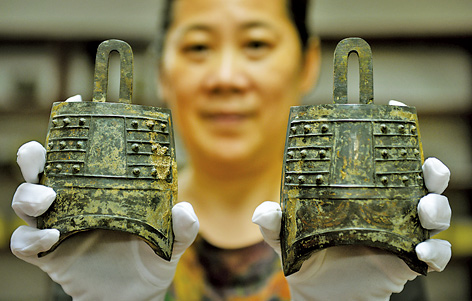Haihun Hou tomb project provides new approaches for archaelogy

A staff member presents unearthed cultural relics excavated in the Haihun Hou tomb.
The ancient city of Zijin, capital city of the Haihun Hou principality, represents one of the best-preserved settlements from the Han Dynasty (206 BC-AD 220). A recently concluded large-scale archaeological excavation of the Haihun Hou tomb has rendered the Haihun Hou site an important state-level piece of cultural and historical heritage. The techniques and approaches used in this project have provided invaluable experience for future projects.
Settlement archaeology
The Haihun Hou tomb was discovered due to a hole left by tomb robbers. On March 23, 2011, locals in Laoqiu Village, Jiangxi Province told Yang Jun, the leader of the Haihun Hou archaeological team, that they had found a hole that might have been used by ancient grave robbers to enter the tomb on Guoguoshan Mountain, located around one kilometer from their village. On hearing the news, Yang instantly dropped the cooking gear he was using and rushed to the scene. “When I arrived there it was already dark. But I could see the grave mound was really big. Marquis tombs excavated in other provinces were the same size, so I was sure that the tomb was of a high rank,” he said. Yang also guessed that it was a Han Dynasty tomb, considering the 30 to 40 cm thick outer coffin was mixed with coal and white mud.
Thanks to aid from the villagers, the tomb avoided further damage. Although the Haihun Hou tomb was not perfectly intact, the main coffin was covered by multiple layers of wood that the grave robbers could not get through.
From 2012 to 2013, the team concentrated on the excavation of the Haihun Hou tomb, outlining the relationship between the minor tombs around the main tomb, and how they were connected to the chariot burial pits, the ancestral temple and the road and drainage system in the cemetery.
Xin Lixiang, director of the Haihun Hou archaeological expert group dispatched by the State Administration of Cultural Heritage, said that archaeological excavations in the past only involved the core tomb, while this time settlement archaeology was included into tomb archaeology: High-grade tombs and their surrounding monuments were taken as one united whole. This represented a step forward in archaeological theories, he said.
Public archaeology
Relics from major archaeological discoveries have to be sent to a relic storage house for repair. It usually takes five to six years to put them on display after related research is completed. But the Haihun Hou excavation project was much more in the public eye. Cameras were rolling on a live show as the project made crucial achievements. Major results were televised, presenting the relics to the public for the first time.
For example, on Nov. 14, 2015, there was live TV program about cleaning the large section that covered the main Haihun Hou coffin. The public could see the newly unearthed golden horseshoe and portrait of Confucius. The 113 freshly excavated relics were displayed in the Zhejiang Provincial Museum only three days after the project was over.
During the excavation and display, archaeologists also made full use of various platforms to publicize the Haihun Hou excavation project, and more than 400 lectures were held. Yang said this frequent media exposure aims to share the results with the public as soon as possible. Modern archaeology needs public participation, he said.
Successive tasks
The five-year excavation project has temporarily come to an end. But Yang said scientific research on the nearly 10,000 newly unearthed cultural relics, such as bronze ware, jade, lacquerware and bamboo slips, still requires long and arduous research efforts.
The excavation has pushed forward many archaeological research subjects. The occupant of the tomb, Liu He, had a complicated status. He had been a civilian, a marquis and an emperor, and the unearthed cultural relics offer good materials to study this complex history. Among various research subjects, further study in some fields might change people’s established perceptions about the Han Dynasty, Yang said. For example, taro residue was found in the newly unearthed round barrel bronze “distiller.” Even today, one of the main raw materials for making saki in Japan is taro. At present, Chinese archaeology indicates the earliest distiller of this style existed in the Yuan Dynasty. If it can be proven that the liquor was distilled as early as the Han Dynasty, then it adds another millenium to its history. In addition, the long lost version of the Analects of Confucius that contains the “Know Chapter” was found in the tomb, which is an exciting finding for Chinese archaeology.
Ming Haiying is a reporter at the Chinese Social Sciences Today.
